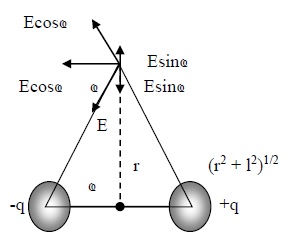Electric Dipole - Electric Field on Equatorial (Transversal) Line
Description:
To calculate electric field created by a dipole on the equatorial or transversal line (on the line perpendicular to the line joining the two charges),
All the measurement of distances are to be taken from the centre(O). Which is the mid point of the dipole
Let the distance between O to +q and O to –q be ‘l’. So, total length between +q and –q will be ‘2l’.
Take a point ‘p’ on the equatorial line at the distance ‘r’ from the centre of the dipole as shown in figure.
Let the angle made by both the charges with respect to the point P be ‘θ’.
Direction of electric field on the equatorial line of the dipole
By coulomb’s law The direction of the electric field at P due to charge +q will be away from itself whereas due to point charge -q , it will be towards itself (-q), in the line joining the two charges as shown in figure.

Note −
Since the magnitude of electric field E+q and E-q are equal so the length of electric field vector are kept same as shown in figure.
To calculate electric field at point ‘P’ due to the two point charges of dipole.
By using the formula for electric field due to point charge,
Electric field due to +q E+q = +14πε0 q(r2 + l2) .....(1)
Since, by Pythagoras theorem the distance between P and +q is (r2 + l2)1/2
Electric field due to -q E-q = -14πε0 q(r2 + l2)
(Electric field due to +q will be positive and electric field due to -q will be negative)
Since the magnitude of electric field E+q and E-q are equal so E-q = E+q = E.
To find resultant electric field,
Resolving the electric field due to both the charges into two components.
From figure −
Sinθ component of electric field due to both the charges cancelled out. As they are equal and opposite in direction.
Cosθ component of electric field due to both the charges added up. As they are in same direction.
So, the resultant electric field (ER) due to both the charges will be −
ER = E Cosθ + E Cosθ
ER = 2 E Cosθ ......(2)
Putting (1) in (2)
ER = 14πε0 2q(r2 + l2) 1(r2 + l2)1/2 [from figure Cosθ = 1(r2 + l2)1/2]
We know that the dipole moment of a dipole is P = 2ql, so on putting it in above equation we get,
ER = 14πε0 P(r2 + l2)3/2
Since, the dipole is very small so ‘l’ is also very small as compared to the distance ‘r’.
So, on neglecting ‘l’ with respect to ‘l’ we get −
ER = 14πε0 Pr3
On comparing the electric field due to a dipole in axial position and in equatorial position we find that −
Electric field at axial position (Eaxial) is double the Electric field at equatorial position (Eequitorial) when ‘r’ is equal.
(Eaxial) = 2(Eequatorial) (Only when ‘r’ is equal)
Resultant direction of electric field in transversal line
The direction of electric field on the equatorial line is always opposite to the direction of dipole moment.
On comparing the electric field due to a point charge and electric field due to a dipole in equatorial position we find that −
As ‘r’ increases the Electric field decreases more in case of dipole as compared to electric field due to a point charge. In dipole E ∝ 1/r3 For point charge E ∝ 1/r2
So we can say − Dipole Electric field depletes faster then electric field by a point charge.

